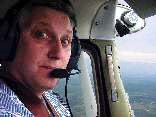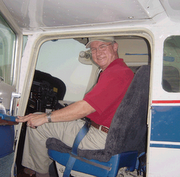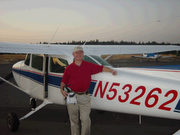How exciting! Of course it won't arrive for a while. They don't have them in stock so we will have a little time to clean the shop, sharpen tools, and get ready for the day Mr. Partain delivers the goods to my door.
We are finishing up the elevators. The right elevator trailing edge was JB Welded Wednesday and this evening I opened it up and started cleaning the excess material.
It looks very straight and I'm very pleased with the product.
Introduction - N9XG
We're building an RV9A together. The tail number is already reserved and is "N9XG"
It's the biggest project either of us has ever started. We're having a lot of fun and learning many things about airplane construction and about ourselves as well. This site is about the process, and our progress.
We will be updating this from time to time with progress reports. If you can't see enough detail in any of the pictures you can click on them and they will expand (like Magic).
It's the biggest project either of us has ever started. We're having a lot of fun and learning many things about airplane construction and about ourselves as well. This site is about the process, and our progress.
We will be updating this from time to time with progress reports. If you can't see enough detail in any of the pictures you can click on them and they will expand (like Magic).
Thursday, January 31, 2008
Saturday, January 26, 2008
Rudder is finished!
Last night we finished off the rudder. The trailing edge turned out very nice. Thanks to Jim Triggs and Paul Westcott for their help and advice. Jim suggested using JB Weld to lock the wedge together with the skin before we riveted.
It worked great! Here is a picture of the assembly curing. In addition to the JB Weld we match drilled two pieces of aluminum angle and clecoed it all together to keep a nice straight edge.
 We also added a reversed wedge to make it all fit together well. You can click on the image to see more detail. Our first application of JB Weld had a few spots that didn't bond. So we reapplied the JB Weld and heated the mix to make it flow better. It worked well.
We also added a reversed wedge to make it all fit together well. You can click on the image to see more detail. Our first application of JB Weld had a few spots that didn't bond. So we reapplied the JB Weld and heated the mix to make it flow better. It worked well.
It worked great! Here is a picture of the assembly curing. In addition to the JB Weld we match drilled two pieces of aluminum angle and clecoed it all together to keep a nice straight edge.

 We also added a reversed wedge to make it all fit together well. You can click on the image to see more detail. Our first application of JB Weld had a few spots that didn't bond. So we reapplied the JB Weld and heated the mix to make it flow better. It worked well.
We also added a reversed wedge to make it all fit together well. You can click on the image to see more detail. Our first application of JB Weld had a few spots that didn't bond. So we reapplied the JB Weld and heated the mix to make it flow better. It worked well.
Saturday, January 19, 2008
Rudder work continues
Last night we formulated a plan for how we would apply the JB Weld to the trailing edge. We are both feeling a little tentative since we have no experience at this. We have a plan though and we have a test joining of two pieces of scrap aluminum. Stay tuned, I will take pictures of the process.
A word of caution. JB Weld is a nice strong adhesive for metal. It takes about 24 hours for it to set up. We learned the hard way that it's important to use saran wrap to keep your clecoes from becoming welded to your work. If you cover the welded area with saran wrap before you clamp it removal of the clecoes is no big deal, but if you don't use saran wrap, I wish you luck on extricating your clamps from the work without buggering up the part. At the very least you will have to destroy some of the clecoes. Trust me!
A word of caution. JB Weld is a nice strong adhesive for metal. It takes about 24 hours for it to set up. We learned the hard way that it's important to use saran wrap to keep your clecoes from becoming welded to your work. If you cover the welded area with saran wrap before you clamp it removal of the clecoes is no big deal, but if you don't use saran wrap, I wish you luck on extricating your clamps from the work without buggering up the part. At the very least you will have to destroy some of the clecoes. Trust me!
Thursday, January 17, 2008
Rudder nearly completed
Last night was spent preparing for finishing up the Rudder. We match drilled two pieces of aluminum angle to hold the trailing edge together. The trailing edge is nice and straight when the angles are attached. I hope it holds that line when we start putting the rivets in.
We also called a couple of mentors to see how they did the trailing edge. We talked about pro-seal and settled on using JB weld. I've never used either one so I'm a little nervous. JB Weld is pretty cheap; about $5.00 for the two tubes. I gather they get mixed together before it's applied.
Tomorrow I will make a trip to the airport to get a couple nylock nuts for the counterweight. Once it is secured we can press on to the finish with the rudder. We are both pleased with the way things are shaping up, but we would like to be moving faster...
We also called a couple of mentors to see how they did the trailing edge. We talked about pro-seal and settled on using JB weld. I've never used either one so I'm a little nervous. JB Weld is pretty cheap; about $5.00 for the two tubes. I gather they get mixed together before it's applied.
Tomorrow I will make a trip to the airport to get a couple nylock nuts for the counterweight. Once it is secured we can press on to the finish with the rudder. We are both pleased with the way things are shaping up, but we would like to be moving faster...
Subscribe to:
Posts (Atom)
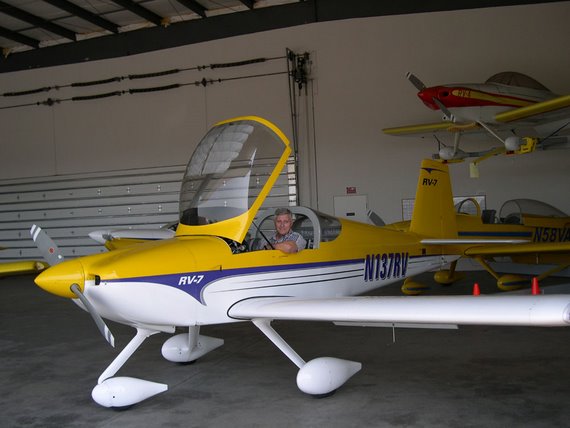
Before we decided to build an RV9A we were looking at the RV7A. This picture was taken on a factory tour.
Standard (aka Slow build) RV9a kit
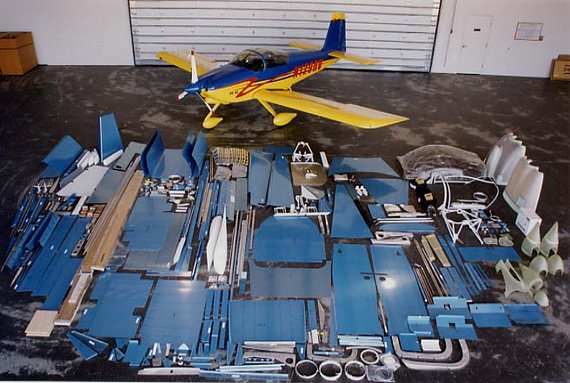
Quick build RV7 kit
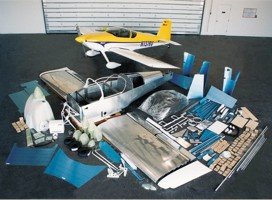
The Process
Most of us think of the airframe as the main thing, and I suppose it is; since you can't fly without it. The kits that Vans sells are match hole punched. That means that the holes are already located and punched when you get them. This saves a lot of time as you can imagine. So what follows is what you do once you've unpacked and inventoried the parts from the factory.
There are several thousands of these planes flying. Rather than making mistakes first-hand, I recommend looking at the web sites of builders who have already done this. Some of my favorite links are provided. You should also look at Van's 'Links' page for the model you're building.
Before touching the parts, it is advisable to read the instructions and review the drawings until you have a clear idea what needs to happen and what sequence it needs to happen in. The drawings are invaluable.
Each sub assembly requires the same basic process:
1. Prepare the parts for fitting. This entails cleaning, filing, and finally scotchbrighting. In addition, some parts require fabrication and/or machining.
2. Fitting is done numerous times. The pre-punched holes are matched to the corresponding part(s) and are held together with clecos.
3. Match drilling is done in assembly to provide optimum fit.
4. Once the holes are match drilled to the proper sizes, the part is disassembled and deburred to remove any sharp edges and irregularities that might result in a poor fit or the development of a crack.
5. Rivets that will be flush with the skin require either a dimple or countersinking. This is normally obvious, but sometimes the rivet needs to be flush and it's not clear at first glance just why.
6. At this point, a coat of primer and (in some cases) paint is applied protect the metal from corrosion. We've decided to prime and paint all skeletal parts; i.e. Spars, Ribs, etc. Skins will be primed where they connect. The method to our madness is this; we want defects to appear first in the skin where they are easiest to fix and pose less of a threat.
7. This is a dangerous part of the process because you might want to rivet something. But WAIT! Review the plans and the directions again.
8. Okay, so you've reviewed the plans and the parts are ready to assemble. Double and triple check the plans to ensure that the proper rivets are used. It's easy to mess this up or get out of sequence.
There are several thousands of these planes flying. Rather than making mistakes first-hand, I recommend looking at the web sites of builders who have already done this. Some of my favorite links are provided. You should also look at Van's 'Links' page for the model you're building.
Before touching the parts, it is advisable to read the instructions and review the drawings until you have a clear idea what needs to happen and what sequence it needs to happen in. The drawings are invaluable.
Each sub assembly requires the same basic process:
1. Prepare the parts for fitting. This entails cleaning, filing, and finally scotchbrighting. In addition, some parts require fabrication and/or machining.
2. Fitting is done numerous times. The pre-punched holes are matched to the corresponding part(s) and are held together with clecos.
3. Match drilling is done in assembly to provide optimum fit.
4. Once the holes are match drilled to the proper sizes, the part is disassembled and deburred to remove any sharp edges and irregularities that might result in a poor fit or the development of a crack.
5. Rivets that will be flush with the skin require either a dimple or countersinking. This is normally obvious, but sometimes the rivet needs to be flush and it's not clear at first glance just why.
6. At this point, a coat of primer and (in some cases) paint is applied protect the metal from corrosion. We've decided to prime and paint all skeletal parts; i.e. Spars, Ribs, etc. Skins will be primed where they connect. The method to our madness is this; we want defects to appear first in the skin where they are easiest to fix and pose less of a threat.
7. This is a dangerous part of the process because you might want to rivet something. But WAIT! Review the plans and the directions again.
8. Okay, so you've reviewed the plans and the parts are ready to assemble. Double and triple check the plans to ensure that the proper rivets are used. It's easy to mess this up or get out of sequence.
Rivets and Riveting
There are thousands of rivets that hold the plane together. Since this is an important task, let's talk a bit about them.
The rivets we'll be using are made of aluminium and are set in one of several ways; Hammering, Squeezing, Pull through.
Hammering a rivet is best done with a partner. One person operates the rivet gun and the other holds a bucking bar on the back side to create a shop head. I've tried doing this alone and almost always with undesirable results. The idea is for the shop head to be approx 1.5 times the diameter of the shank of the rivet.
Squeezing a rivet requires a special tool and is my preferred way whenever possible. Some folks use a manual squeezer, but I like pneumatic squeezer. They develop approx 3,000 pounds of force in the last 1/8th inch of the piston's travel. So proper adjustment is important. Once adjusted properly it will deliver consistent rivet sets.
Pull through (aka Blind or Pop) rivets are for those applications where there is no way to get access to the back side of the rivet. In general this type of rivet has inferior strength characteristics compared to a solid rivet. The noteworthy exception is the Cherry Max rivet. It is a pull through rivet, but it is also structurally rated and not cheap.
The rivets we'll be using are made of aluminium and are set in one of several ways; Hammering, Squeezing, Pull through.
Hammering a rivet is best done with a partner. One person operates the rivet gun and the other holds a bucking bar on the back side to create a shop head. I've tried doing this alone and almost always with undesirable results. The idea is for the shop head to be approx 1.5 times the diameter of the shank of the rivet.
Squeezing a rivet requires a special tool and is my preferred way whenever possible. Some folks use a manual squeezer, but I like pneumatic squeezer. They develop approx 3,000 pounds of force in the last 1/8th inch of the piston's travel. So proper adjustment is important. Once adjusted properly it will deliver consistent rivet sets.
Pull through (aka Blind or Pop) rivets are for those applications where there is no way to get access to the back side of the rivet. In general this type of rivet has inferior strength characteristics compared to a solid rivet. The noteworthy exception is the Cherry Max rivet. It is a pull through rivet, but it is also structurally rated and not cheap.
Removal
When rivets are set badly (as is sometimes the case) You need to decide if it's so bad that it just has to be replaced or is it okay as is. The main concern is to remove the offending rivet without doing damage to the hole it's in; e.g. enlarging or elongating or both.
When rivets are set badly (as is sometimes the case) You need to decide if it's so bad that it just has to be replaced or is it okay as is. The main concern is to remove the offending rivet without doing damage to the hole it's in; e.g. enlarging or elongating or both.
If it just doesn't pass muster, get a drill bit about the diameter of the rivet shaft or smaller. Center punch the head of the rivet (solid rivets only) and then carefully drill thru the head just down to where the shaft meets the hole. Once this is done, insert and old drill bit into the hole and wiggle the head until it snaps off. Once the head is off you should be able to push it out with a punch.
With pull through rivets this can be problematic, as the shaft is most likely steel and may turn with the drill bit. Another problem with removing blind rivets is this. Blind rivets are used because access to the back side is either difficult or impossible. Onc you commit to removing the blind rivet, you have to figure out how to remove the back side when you punch it thru the hole.
